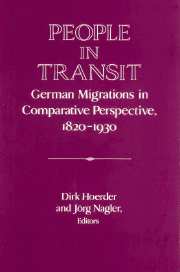Book contents
- Frontmatter
- Introduction
- PART I CONTINUITY AND COMPLEXITY: MIGRATIONS FROM EAST ELBIAN GERMANY AND GALICIAN POLAND
- Part II Internal German Migrations and In-Migrations
- PART III WOMEN'S MIGRATION: LABOR AND MARRIAGE MARKETS
- 10 The International Marriage Market: Theoretical and Historical Perspectives
- 11 Making Service Serve Themselves: Immigrant Women and Domestic Service in North America, 1850-1920
- 12 German Domestic Servants in America, 1850-1914: A New Look at German Immigrant Women's Experiences
- 13 Acculturation of Immigrant Women in Chicago at the Turn of the Twentieth Century
- PART IV ACCULTURATION IN AND RETURN FROM THE UNITED STATES
- 18 Migration Past and Present - The German Experience
- 19 Research on the German Migrations, 1820s to 1930s: A Report on the State of German Scholarship
- Index
11 - Making Service Serve Themselves: Immigrant Women and Domestic Service in North America, 1850-1920
Published online by Cambridge University Press: 05 January 2013
- Frontmatter
- Introduction
- PART I CONTINUITY AND COMPLEXITY: MIGRATIONS FROM EAST ELBIAN GERMANY AND GALICIAN POLAND
- Part II Internal German Migrations and In-Migrations
- PART III WOMEN'S MIGRATION: LABOR AND MARRIAGE MARKETS
- 10 The International Marriage Market: Theoretical and Historical Perspectives
- 11 Making Service Serve Themselves: Immigrant Women and Domestic Service in North America, 1850-1920
- 12 German Domestic Servants in America, 1850-1914: A New Look at German Immigrant Women's Experiences
- 13 Acculturation of Immigrant Women in Chicago at the Turn of the Twentieth Century
- PART IV ACCULTURATION IN AND RETURN FROM THE UNITED STATES
- 18 Migration Past and Present - The German Experience
- 19 Research on the German Migrations, 1820s to 1930s: A Report on the State of German Scholarship
- Index
Summary
“Domestic service was clearly considered undesirable by most working women,” reads a remark in the concluding chapter of a study of household employment in industrializing America. This comment is representative of historical and contemporary literature that paints an overwhelmingly negative picture of domestic service. In most studies, women are described as forced into domestic service due to lack of technical skills, gender segmentation of the labor force, and, for immigrants and nonwhites, lack of language abilities and racial or ethnic prejudice.
This view of domestic service is accurate at a general level. Many working-class women viewed their experiences as domestic servants negatively as they toiled in middle- and upper-class homes in the United States and Canada, and many avoided such employment whenever possible. But this negative assessment should not be applied uncritically to all domestic servants. Many female immigrants to North America in the late nineteenth and early twentieth centuries worked as maids, and found in domestic service many positive features. Most of these women perceived domestic service as a sought-after occupation. It met many of their needs as immigrant females and represented a type of employment that they were able to make “serve themselves.”
With few economic opportunities at home, and apparently many abroad, young women decided to try their luck in another country. Maja Johansson described her decision to emigrate: “I had a place as a domestic. . . in Halmstad. In five years the wages never got higher than ten kronor a month and there was no set work time, so when I heard how much better domestics had it in America my thoughts went there. . . . In 1909 I left.” For many northern European women like Maja, social and cultural background — where patriarchal and relatively rigid class structures limited their economic and social opportunities — encouraged participation in American domestic service. Servant work was considered gender appropriate employment by the home culture, prior experience in the occupation eased anxiety about ability to perform work tasks, and the comparatively better social and economic conditions of servants in the United States compared with the homeland made the job an attractive employment choice.
- Type
- Chapter
- Information
- People in TransitGerman Migrations in Comparative Perspective, 1820–1930, pp. 249 - 266Publisher: Cambridge University PressPrint publication year: 1995

